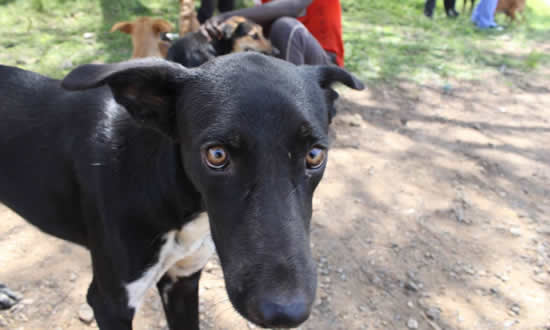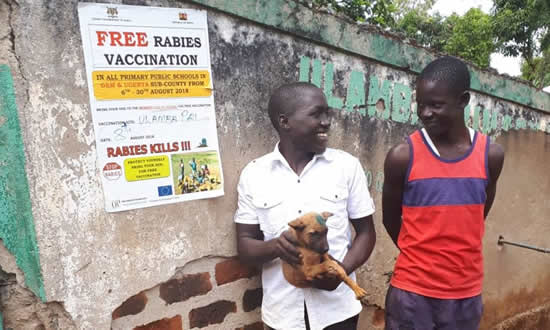
Rabies was first officially reported in Kenya in 1912 in a dog on the outskirts of Nairobi. The first human case of rabies was reported in 1928 in a woman from the Lake Victoria basin region in Western Kenya. In the years following 1930 to mid-1950, dog-mediated human rabies and the disease in the dogs were widely reported throughout the country. Rabies epidemics prompted the government to commence widespread mass dog vaccination campaigns starting in the late 1950 to early 1970. By 1973, the campaign was so successful that the disease was almost eliminated in the country. Unfortunately, the breakdown in vaccination efforts resulted to the spread of the disease and establishment of the endemic disease status that remains to date.
Rabies is currently listed as one of the top five priority zoonotic diseases in Kenya for control. It is estimated to kill about 2,000 people annually with parts of Mid-eastern (Machakos, Kitui, Makueni counties) and Western Kenyan (Siaya, Kisumu and Homa Bay) counties traditionally reporting the highest incidence of the disease. While the overall dog bite annual incidence (bites/human population) in Kenya varies between 300-400/100,000, this is thought to be grossly underestimated.
The recognition that sustained mass dog vaccination against rabies of greater than 70% of the dog population is the single most cost effective intervention to control and eliminate dog-mediated human rabies led the Government of Kenya in 2015 to develop a 15 year joint animal and human health sectors strategy plan. Such plan has the objective to progressively reduce the rabies burden in the country with the aim of eliminating dog-mediated human rabies cases in Kenya by 2030. The strategy is jointly implemented by the Ministry of Health and the Veterinary Services of the Ministry of Livestock through a Zoonotic Diseases Unit (ZDU). The rabies strategy plan is a comprehensive, risk-based stepwise approach to rabies elimination that proposes a progressive reduction of disease risk, allowing for coordination of county and sub-county activities to achieve disease elimination. There are six stages involved in the stepwise approach towards rabies elimination. Each stage is built on the previous one with the ultimate goal of reducing the risk of the disease in the last stage until the country is declared free of rabies.
The first stage of implementing the strategy through annual mass-dog vaccination is being developed in selected pilot counties that have been chosen based on high disease burden and the presence or absence of natural barriers such as mountains and water bodies. The pilot areas selected with natural barriers include Kisumu and Siaya counties in Western Kenya, which have Lake Victoria on the West and the Nandi escarpment to the East as barriers to natural dog movement. The other selected counties include Makueni, Machakos and Kitui located to the east of Nairobi. These counties have no natural barriers but have a high disease burden. Lessons learnt from the pilot counties will be used to better implement the strategy in the rest of the country. Other areas that have also adopted yearly mass dog vaccination campaigns include Kajiado and Laikipia counties located to the south and northwest of Nairobi respectively.
Activities carried out in the pilot areas include yearly mass dog vaccinations, reporting of dog bites through a toll-free number, post vaccination surveys and active surveillance. The implementation of these activities is possible thanks to the coordination of the national and county governments and the support from international partners, such as the World Organisation for Animal Health (OIE), World Health Organization (WHO), Food and Agriculture Organization (FAO) of the United Nations, among others.
The Pan African Rabies Control Network (PARACON), with the Global Alliance for Rabies Control (GARC) as secretariat, also supports the coordination of rabies control networks in the African Region and provides a platform for different regions to share and learn from each other experiences.
Kenya aims at reaching vaccination coverage of, at least, 70% of dogs in each region yearly for a period of three years in order to achieve the elimination status. Thereafter, a maintenance phase supported by effective surveillance and outbreak response system will follow. Additionally, the national strategy objectives include increasing public awareness on rabies, availing timely post exposure vaccines to bite patients as well as establishing an effective surveillance system for animal and human rabies.
Scientific evidence provides strong support to the fact that rabies can be eliminated today. Zero deaths from dog-mediated human rabies by 2030 is a goal that can be achieved…


